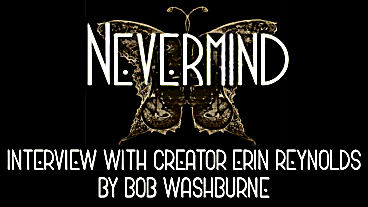
Interview with Erin Reynolds of Flying Mollusk, Creator of Nevermind
Nevermind sets itself apart by integrating biofeedback into the gameplay. We sit down and talk with creator Erin Reynolds.





When I played Nevermind (you can find my review [HERE]) I was impressed with its use of biofeedback sensors to allow the game to sense your fear. Unfortunately, at the time, I didn’t own any of their supported sensors and so had to rely on the game’s ability to sense fear through my gameplay.
But Flying Mollusk is expanding its game by supporting three new interfaces, including the Apple Watch and web cams, as well as entering the VR movement with Oculus Rift. The webcam-based emotional biofeedback update is available now, while support for Apple Watch and the Oculus Rift will occur later this Spring.
I will be getting my Oculus Rift next month, just about the time Flying Mollusk releases its update. So it looks as though I’ll have to play Nevermind again so I can review it as a VR experience.
Until then, I thought I would touch base with Erin Reynolds, Chief Mollusk, and get some of her thoughts about just what was happening inside the bivalve studio
Just Adventure (JA): What was your inspiration for Nevermind?
Erin Reynolds (ER): Nevermind started as my Masters thesis back in 2011 at the University of Southern California in the Interactive Media and Games Division of the School of Cinematic Arts. From the beginning, I wanted to create a game that leveraged biofeedback-based interactions (something I had explored a couple of years’ prior) that also would positively impact the player. In other words, a game that was just as beneficial as it was entertaining. I also wanted to create a game with horror-aesthetics (something I always had wanted to do but hadn’t had the opportunity to do so previously in my career). Nevermind emerged, in part, out of an ambition to use my thesis year as a chance to challenge myself to explore combining all three goals into one (hopefully) amazing game.
JA: What was your greatest challenge in development?
ER: Given that Nevermind is a fairly unusual game in more ways than one, there were many challenges that we faced in developing it. For example, when integrating a new and innovative technology such as biofeedback, there were, inevitably, many challenges; not only in designing for the tech itself, but also in evangelizing the potential of biofeedback technology as a whole. Even proving to the world that something of this nature is even possible proved to be a challenge back in the early days. We’re elated to see that now, in 2016, the concept of biofeedback-based games is generally no longer thought to be something that can only exist within the realm of science fiction.
JA: What part of the game/development are you most proud of?
ER: Creating experiences that both entertain and help people in some way, shape, or form is both what I’m most proud of and most motivated by every day.
JA: If you could go back and change/expand one thing, what would it be?
ER: We’ve always envisioned Nevermind as being an experience with 10 or more levels – our only limitation has been the resources needed to make that happen. While there isn’t much I could do about that even if I could go back in time, it is something that we hope we will have the opportunity to expand upon in the future.
JA: What was the Kickstarter experience like for you?
ER: Fantastic! The support, feedback, and guidance of our Kickstarter backer community has been incredible throughout the entire crowdfunding and game development experience.
JA: What advice can you give to other Kickstarter projects? (Especially how to get the word out)
ER: Every project is different – so no one piece of advice fits all. However, I always urge folks looking to crowdfund a project to never underestimate the true value of a crowdfunding project: getting to meet folks who share your vision and who want to see it happen as much as you do.
JA: Are there any “Shout Outs” you would like to make for other Kickstarter projects?
ER: There are so many amazing ideas launched via crowdfunding platforms every day. Instead of a specific shout-out, I’d encourage anyone to simply browse what’s out there — you’d be amazed at what wonderful and niche works of art and ingenuity you’ll find that need your support.
JA: How can existing players such as myself take advantage of the upgrade coming out soon?
ER: Distribution is being handled by Steam and the updates will come through them. (sic)
JA: I was put off when I saw that the cheapest device was $100 and would only be useful (to me) for this one game. What else can your supported devices be used for beyond the game (so that their purchase might be justified?)
ER: All of the heart rate devices we support have purposes outside of the game — such as for exercise training, meditation practice and, in the case of RealSense technology, hundreds of other applications.
More importantly, with our newly-integrated webcam-based emotional biofeedback using Affectiva’s Affdex technology, now no additional hardware is required to access biofeedback features. For more about the difference between the heart-rate-sensor-based physiological biofeedback and the webcam-based emotional biofeedback, feel free to reference this page: www.nevermindgame.com/tech.
JA: Your technology is quite impressive. What else could it be used for besides this one game? Do you plan to market it?
ER: We see limitless possibilities for biofeedback in games and other experiences and look forward to continuing to work with it in future projects.
JA: Could you please give a few examples?
ER: In gaming, one of perhaps the most obvious and applicable uses of biofeedback is creating a dynamic difficulty system that automatically adjusts a game’s level of challenge depending on whether the player is bored or overwhelmed – helping him/her stay in the “flow state” based on subconscious signals. Beyond “entertainment gaming,” it also has uses in areas such as education and educational games in terms of helping to assess engagement, interest, confusion, etc. There are also several exciting implications of this technology being used in health-care applications and games by opening up new possibilities for more engaging and accessible diagnostic tools. The list of possibilities is truly limitless.
JA: Many players do not like mazes and find them frustrating. How does your technology tell the difference between true fear and mere frustration?
ER: With Nevermind’s new ability to interpret both physiological and emotional biofeedback, it can now look at both psychological arousal and valence to be able to sense indications of more nuanced feelings. That said, the game intentionally reacts to both fear and frustration in similar ways since our goal is, after all, to help players become more mindful of any potential sensations of fear, frustration, anxiety, stress, etc.
JA: Personally, I had difficulty with immersion. I never lost the sense that I was an outsider looking in on someone else’s issues. As a result, the game did not seem to respond to my game play and jack up the experience. What might the player do to improve immersion?
ER: If you’re playing with a sensor, you may want to consider increasing the sensitivity setting in Options as every person is a little different. Also, as with any game, immersion can typically be improved with playing with headphones, adjusting ambient room lighting, etc. At the end of the day, though, any game experience isn’t one-size-fits-all, so some players might have an easier time becoming immersed in and empathizing with each patient than others.
JA: Do you or will you be supporting VR technology (such as Oculus Rift, which I have already ordered) or 3D Audio?
ER: Yes, we’re very excited about the VR Nevermind experience that will be available later this Spring! I may be biased, but experiencing virtual reality with biofeedback is a pretty cool and unique experience.
JA: What can you tell us about your next project?
ER: We have lots of ideas for future projects, but our focus continues to be on Nevermind at this point in time.
JA: And, of course, what else would you like to tell us about Nevermind?
ER: Now that anyone can experience the biofeedback features with pretty much no additional hardware other than a min-spec machine and a webcam, we’re really excited that more people than ever can enjoy Nevermind with its intended biofeedback experience.
Nevermind Review – November 13, 2015

Erin Reynolds, Creative Director and CEO at Flying Mollusk

Leave a Reply